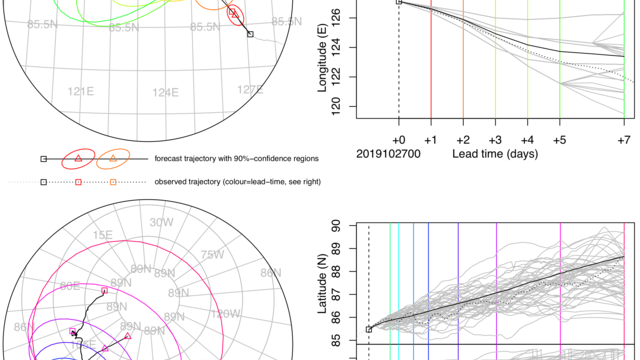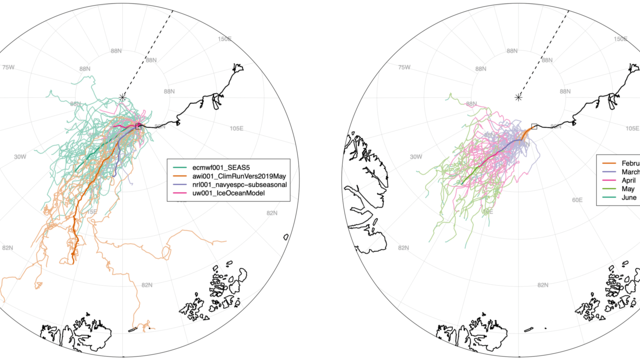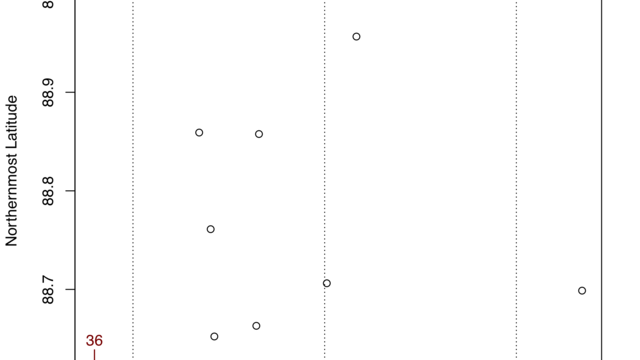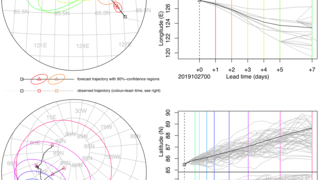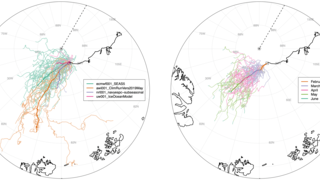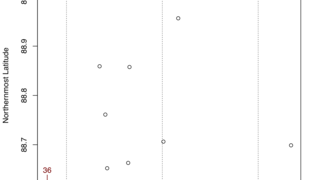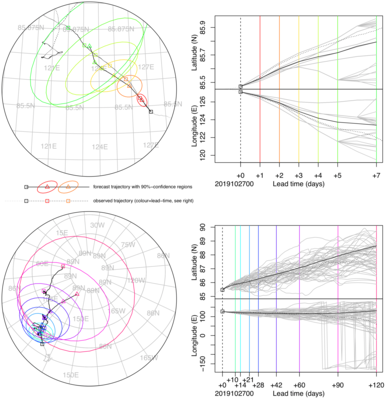Summary
Current predictions by international forecast centres and researchers, collected and evaluated by the Sea Ice Drift Forecast Experiment (SIDFEx), suggest that there is a chance that the drift will take the expedition even further North. However, the tight grip of the westward Transpolar Driftstream makes it unlikely that the ship will pass the North Pole in the direction of North America. There is other good news: The probability to get pushed into the open ocean before October 2020 is still not more than 10-15%.
On Sunday, February 23rd 2020, the MOSAiC expedition onboard the icebreaker RV Polarstern reached 88.5987°N, besting the northernmost point of Fridjof Nansen’s expedition 125 years ago by more than two degrees. While Nansen’s goal was to reach the North Pole, MOSAiCs science plan has no specific interest in this target. Nevertheless, being so close, the question how close to the pole MOSAiC will get is on the mind of participants and observers. Is the camp destined for a continuation of its straight course toward the Fram Strait, named after Nansen’s ship, or could the expedition still pass the pole on the “other side”, across the date line?
Drift forecasts are essential for the planning of expeditions
When planning the route for his 1893 expedition to reach the North Pole, Nansen had little to go by other than a few pieces of debris from the shipwrecked Jaennette that had been found off the south-west coast of Greenland. After more than a century of research and innovation, planning and execution of science missions such as MOSAiC can now draw on millions of Earth observations and complex weather and climate models running on supercomputers that simulate the evolution of our environment based on the laws of physics. The planning for the MOSAiC drift, in particular where and when to start, relied on satellite observations of Arctic sea ice drift from the previous two decades. This historical information provided a sense of what one might expect for 2019/20. Many months before a planned mission, such climatological information so far remains the best planning tool. This is because modern forecast systems that simulate the ice motion have difficulty adding much skill beyond several weeks forecast lead time. The chaotic nature of the atmosphere makes the winds that drive the ice motion largely unpredictable beyond some point.
However, when it comes to the drift over the next days to weeks, real-time information from modern forecast systems can sharpen the prediction significantly. These forecasts are useful for mission planning and for applications such as the ordering of high-resolution satellite images of targets moving with the ice. Assessing how well these systems work, how to improve them, and how to best integrate them with historical information to generate seamless forecasts from days to months, is the main motivation for the Sea Ice Drift Forecast Experiment (SIDFEx), an initiative of the Year of Polar Prediction (YOPP). Instead of providing forecasts based on a single system, SIDFEx is bringing together forecasts from more than a dozen systems from many countries, to increase accuracy and to characterize forecast uncertainty.
Forecast Method
After two years of preparations and testing with buoys of the International Arctic Buoy Program (IABP), SIDFEx now provides a consensus forecast for MOSAiC that is updated every six hours. The first part of each consensus forecast is constructed from several short-term forecast systems (listed in the weblinks below) that cover lead times up to ten days. Those systems involve weather forecasts that “know” about the current atmospheric situation. Unfortunately, due to logistical hurdles, even these forecasts are typically already one day “old” when our consensus forecast is constructed and therefore do not take advantage of the most recent (known) position information. To fix this, the outdated part of each short-term trajectory is truncated and the remaining part is shifted so that the location at the initial time of the consensus forecast matches the observed location. Moreover, at the time when the trajectory of each short-term forecast ends, several ensemble members of a (less frequently updated) seasonal forecast take over – again with truncation and shift so that the trajectories remain continuous – resulting in a “seamless” drift forecast, including ensemble-based uncertainties, covering the next 120 days.
Results
Comparing the observed drift path to the consensus forecast issued 120 days ago reveals that the northward progress of the MOSAiC site unfolded as expected, whereas the site was carried further westward than expected on average (Fig. 1, bottom). However, the actual position remained within the estimated 90%-confidence bounds of the forecast, which also holds for the short-term part of the forecast (Fig. 1, top).
Consistent with the satellite-derived climatological forecasts, the SIDFEx forecasts issued during the first one or two months of the campaign indicated a similar likelihood to pass the North Pole on the Atlantic side, across the Greenwich meridian (0 Deg Longitude), or on the Pacific side, across the Date Line (180 Deg Longitude). However, progress of the drift through the ice has shifted the odds significantly in favour of a passing across the Greenwich meridian. In fact, not a single of the individual trajectories of the most recent individual extended-range forecasts crosses the Date Line, although some miss it only by a very small margin (Fig. 2, left). That margin becomes broader when current short-term forecasts, indicating a further westward drift with increasing southward component for the next few days, are taken into account, as it is the case in the SIDFEx consensus forecast (Fig. 2, right).
So, what does this mean for how far north MOSAiC will still go, and when will this point be reached? According to the SIDFEx consensus forecast (Fig. 2, right), there is a 30% probability that the latitude of 88.5987°N reached on Sunday will be surpassed (Fig. 3). A northernmost latitude beyond 89°N appears possible, too, although only one of the 51 trajectories reaches so much to the north. Concerning the time when the record latitude will be attained, anything between the past Sunday and May seems possible (Fig. 3).
Finally, does the faster-than-expected westward drift have implications for a possible earlier end of the campaign by drifting out of the pack ice earlier than planned? The theoretical chance of this happening makes scientists and mission planners look with interest at the progress of the ship. The SIDFEx consensus forecast does not reach far enough ahead, but the most recent satellite-derived climatological forecast (Fig. 2, brown curves) does. And it has some relieving news for those that hope to complete the full year of MOSAiC measurements: The probability to get pushed into the open ocean before October 2020 is still not more than 10-15%.
Scientists always caution that absolute certainty in forecasts is not attainable. However, it would be a surprise if the MOSAiC drift would take a turn and still make it across the Date Line; too strong is the grip of the Transpolar Drift Stream. Those onboard Polarstern should enjoy the proximity to Nansen’s goal while they can, because forecasts call for a southward course soon.
References
Fridtjof Nansen, 1897: Some Results of the Norwegian Arctic Expedition, 1893-96, The Geographical Journal, Vol. 9, No. 5 (May, 1897), pp. 473-505. zenodo.org/record/1449224
Quote: „Among the others who made investigations before in the same direction, I must mention Professor Moha, who, when the articles from the Jeannette were found in 1884 on the south-west coast of Greenland, pointed out that they must have drifted straight across the polar basin north of Franz Josef Land and Spitzbergen, and down along the east coast of Greenland.“ Page 492
Questions?
Contact us via E-Mail or our contact form.
Graphics
